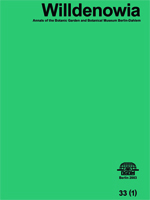BioOne.org will be down briefly for maintenance on 14 May 2025 between 18:00-22:00 Pacific Time US. We apologize for any inconvenience.

Bericht über den Botanischen Garten und das Botanische Museum Berlin-Dahlem (BGBM) für das Jahr 2002
No abstract available
No abstract available
No abstract available
